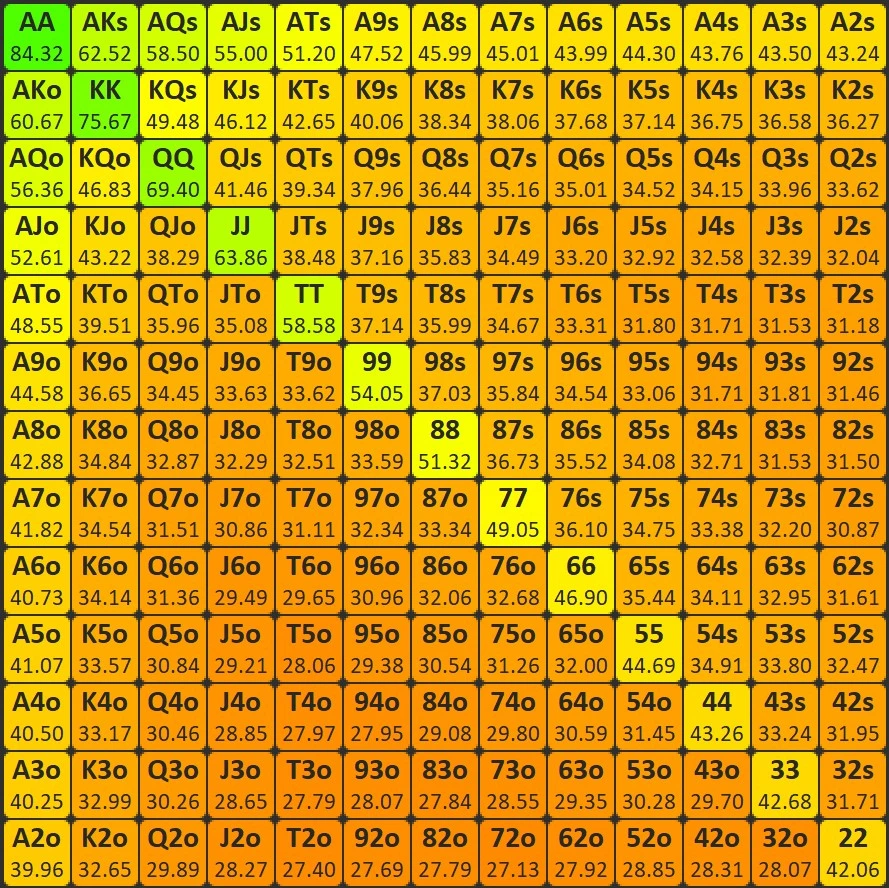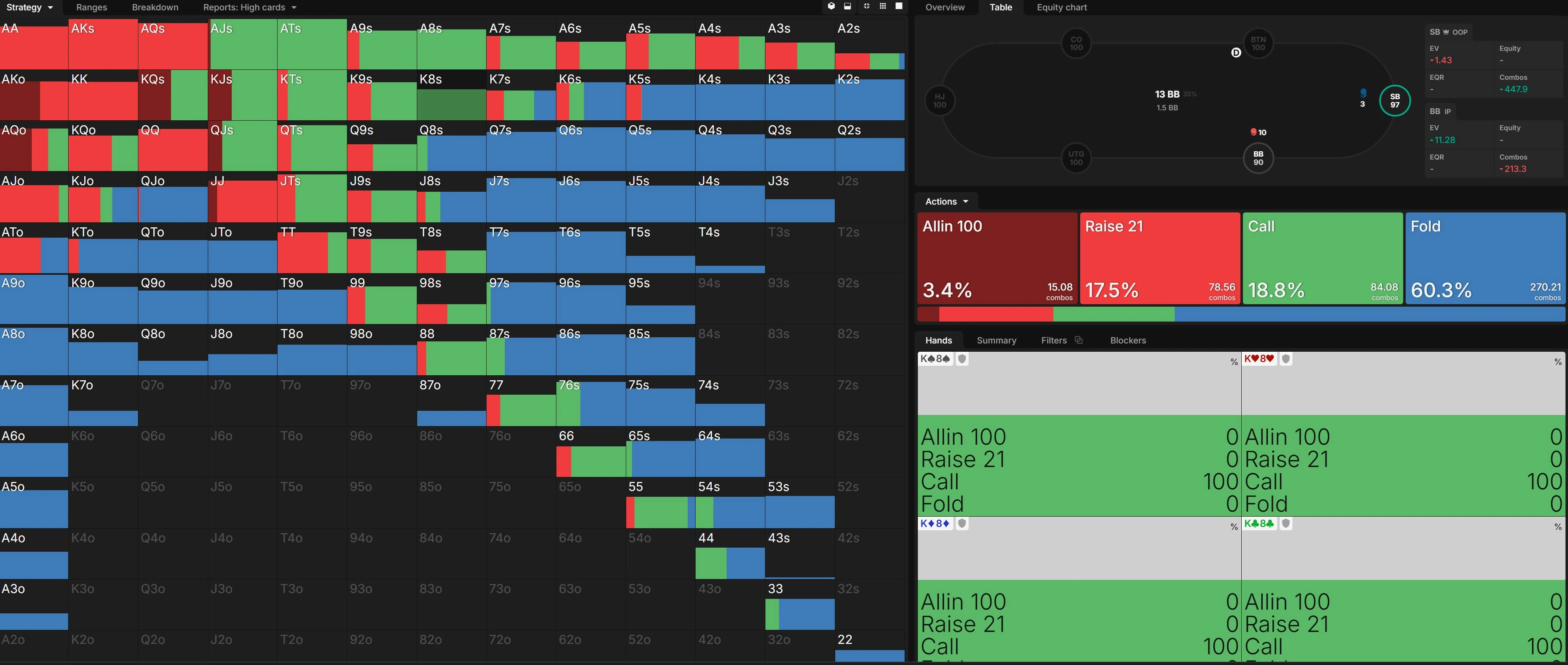Poker Blind Strategy: Defending Your Blinds

Apr 16, 2025
•
2 min read
Your big blind defense strategy is primarily based on your pot odds to call, your opponent’s raising range, and how well your hand realizes equity.
- Upswing Poker.
Welcome to the last installment of our preflop strategy guide, and perhaps the most theory intense. Over the past two articles, we covered preflop GTO charts and optimal sizings to use as we raise-first-in, or 2-bet as well as re-raise in 3-bets and 4-bets.
Now, we’ll cover the reason all this action exists: poker blinds. If you’re ready to learn the secrets professionals know about poker blind defense, then keep reading!
What Is a Blind in Poker?
A blind is a forced bet placed by players before seeing their cards, creating an initial pot and giving everyone a reason to compete. Without blinds or antes, the best strategy would be to play only with pocket Aces.
Why risk anything when there’s no reward? This is what makes blinds so essential: they drive the action, create stakes, and ensure every hand has something to fight for.
With every player competing for the blinds—bets placed without seeing their cards—strategies must balance risk and reward. So, how can we protect ourselves, and do we really need to?
The Blind Baseline
In poker, each hand typically features two blinds: the small blind, which is about half the minimum bet, and the big blind, which is the full minimum bet. Together, these create a starting pot of 1.5 big blinds (bb) before any cards are dealt.
Win rates by position reveal the impact of blinds. For example, if the big blind folded every hand to a pre-flop raise, its win rate would be -100bb per 100 hands.
Losing less than the default -100bb/100 hands in the big blind, or -50bb/100 hands in the small blind, indicates effective play. But how do we know when fighting for our blinds is worth it?
The answer lies in pot odds. This risk/reward ratio tells us that, when facing a minimum bet, continuing from the big blind requires just 22.22% equity, assuming no rake. Facing a 2.5bb open, we need at least 27.3% equity to continue, and for a 3bb open, that threshold rises to 30.8%.
GTO opening ranges show that some hands will exceed these equity thresholds. Folding such hands costs money, which is why identifying and defending with them forms the foundation of an effective blind defense strategy.
Blinds Strategy
Let’s explore how much equity each hand in our blind range holds against typical opening ranges. Consider a 6-max cash game with the under the gun (UTG) and button (BTN) positions.
GTO ranges suggest UTG opens with around 17.5% of the best hands, while BTN opens with approximately 42%. Even the weakest hand in the blind range, 72o, holds over 27% equity against UTG's range and over 29% against BTN's range.

Does this mean we usually end up calling no matter what against small open raises? No!
The reason is equity realization. We’ll get into the mathematical definition in a later chapter, but for now understand that describes how often we get to showdown, the point where these equities materialize.
Being out of position, we’re often forced to fold before the river. So, while we might have 27% equity, in practice we might only see 22%.
These aren’t our profit making spots, but “lose the least” scenarios. Furthermore, calling is not the only option blinds have for defense. They can also 3-bet. After all, Aces, Kings and other premiums are also dealt to the blinds.
Big Blind: Key Points
- Positional Advantage: acting last preflop gives you critical information about your opponents' actions and ranges. This advantage makes the big blind a position of both defense and opportunity.
- Defensive Strategy: when looking at GTO defense charts, we see that we let go of about 60% of our worst hands against typical online open-raise sizes under 2.5bb. Against UTG we 3-bet about 5% of the time, increasing that re-raise figure up to ~14% against wide opening button.
- Hand Selection: suited connectors and gappers, like 75, are ideal for defense. These hands have the potential to dominate premium holdings, such as pairs and sets, especially in favorable board textures.
- Adapting to Opponents: against regs, stick to simplified GTO-inspired ranges to maintain balance and avoid exploitation. Against fish, be mindful of their larger-than-average raises and tighten your range slightly against them.
- Low SPR Awareness: avoid entering low SPR (stack-to-pot ratio) situations when out of position. These scenarios limit postflop maneuverability and increase risk, making it harder to profitably defend.
Small Blind: Key Points
- Preferred Actions, 3-Bet or Fold: The small blind is generally better suited for either folding to open-raises or 3-betting aggressively. Calling is often suboptimal, as it exposes you to potential 3-bets from the big blind.
- Simplifying the Strategy: while some GTO charts include overcalling the small blind, it’s best to simplify your play. Unless specific factors, such as a multiway pot or a weak player in the big blind, justify a deviation, adopt a straightforward 3-bet or fold strategy.
- Cash Games vs. Tournaments: Although the general principles of small blind play apply to both cash games and tournaments, there are critical differences to consider. Keep reading to know the difference.
Blinds in Tournament Play
Since a poker blind remains constant in cash games but constantly increases in tournaments, defending the blinds becomes more important when playing a tourney.
For one, if you have to take a break in a cash game and miss a blind, you’ll just get sat out. If that happens in a tournament, your missed blinds get added to the pot every orbit. You could just get blinded out of the event all together!
You have to play WAY looser in the big blind in tournaments than you do in a cash game.
- Doug Polk.
For this reason, especially as a short stack, you’re going to defend way more than in cash games. Fortunately, GTO Wizard does offer solutions based on varying tourney stacks.
We recommend you get familiar with short-stack blind defense if tournaments are your thing. The topic deserves it’s own article, if not book, but know that the big-blind does little folding when short-stacked in a tournament.
You’re going to be calling and 3betting, perhaps even all-in quite frequently. Forfeiting 5% or more of your stack often simply doesn’t pay off.
Blind vs Blind
Although we usually face an open in the field, we find ourselves in a poker blind vs. blind scenario often enough that we must prepare you for this ongoing war.
GTO charts have SB folding roughly the bottom half of their range and usually open, raising the rest to a larger size since BB will have position. For beginners, we recommend always open raising. It’s simpler to execute, since we don’t have to worry about trapping strong hands to not cap ourselves.
When playing regs, expect lots of 3-bets and 4-bets in these spots. 3bet the BB heavy vs SB opens. Similarly, 4-bet the SB often facing 3-bets from the BB. Blockers actually matter here since you want to reduce the odds of your opponent having strong hands.

When fish limp their SB, abuse them. Always go for a raise with any hand you want to play. The better you get, the more hands you can play since you’ll have such a huge post flop advantage being in position against a weak player.
Conclusion
In short, playing the blinds comes down to defense. We’re looking to cut the bleeding as much as possible here. There’s no shame in cutting losses and moving on. Although we’ll be offered great pot odds, we often have to forfeit our poker blind since we’ll have a hard time realizing equity out of position.
Blind defense takes on extreme meanings in tournaments, especially with short stacks. Those chips make up a larger portion of your stack and bleeding away there often means losing the tourney.
In tournaments and cash games, blind vs blind scenarios tend to create an all out war where we must prepare to re-raise and re-raise frequently. With practice, these tense moments become easier to handle.
Congratulations on completing the pre-flop module of our beginner’s poker course. We look forward to sharing more secrets with you on post-flop play. Thanks for reading!
ZOOM IN
The following links are recommended resources related to this section’s theme. Don’t stay in doubt--dive in! 🔔
- Increasing Blinds: Inform yourself on tournament specific strategies so you’re not blinded out!
- Solved Tourney Defense: You may want to check ICMIZER.
- Ranges: Learn how to calculate & use poker ranges.
- Discord Community: Join the coolest poker community, don’t be shy! Use it to ask questions and interact with other poker enthusiasts and professionals.